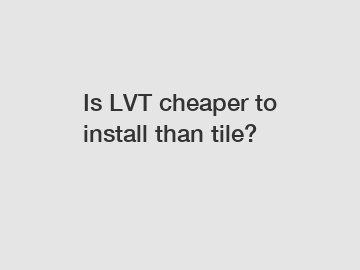Is LVT cheaper to install than tile?
Is LVT Cheaper to Install Than Tile?
LVT, which stands for Luxury Vinyl Tile, has gained significant popularity in recent years as a cost-effective alternative to traditional tile flooring. Many homeowners are drawn to LVT because of its affordability, durability, and ease of installation. But is LVT actually cheaper to install than tile? Let's delve into this question and examine the key points.
1. Cost of Materials:

When it comes to the cost of materials, LVT is generally cheaper than tile. Vinyl flooring is manufactured using synthetic materials, making it more cost-effective to produce. On the other hand, ceramic or porcelain tiles require raw materials such as clay, minerals, and natural resources, which usually come at a higher price. Therefore, in terms of material expenses, LVT is a winner.
2. Installation Expenses:
Installing LVT is significantly less complex and time-consuming compared to tile installation. The simplicity of LVT installation often means that it can be done as a DIY project, saving homeowners the cost of hiring a professional. In contrast, installing tile requires specialized skills, tools, and techniques, making it more suitable for professional installation. Consequently, the cost of hiring a tile installer can significantly add up. Thus, in terms of installation expenses, LVT proves to be more cost-effective.
3. Subfloor Preparation:
One aspect where tile may have an advantage over LVT is subfloor preparation. Tiles require a perfectly level and sturdy subfloor to ensure a durable and long-lasting installation. This may necessitate additional preparation work, such as floor leveling or the installation of cement board or backer board. These extra steps can increase both the time and cost associated with tile installation. In comparison, LVT can be installed over a wider range of subfloors and is more forgiving when it comes to minor imperfections. Therefore, LVT could potentially save you expenses related to subfloor preparation.
4. Long-Term Maintenance and Durability:
Although LVT may have a lower initial installation cost, its long-term maintenance and durability should be considered. Tile floors, particularly ceramic or porcelain, are known for their exceptional durability, making them suitable for high-traffic areas. They can withstand heavy furniture, moisture, and even pet claws without showing significant signs of wear and tear. On the other hand, while LVT is highly resistant to scratches, dents, and moisture, it may not have the same longevity as tile. Over time, LVT may require replacement in certain areas that experience heavy foot traffic. Therefore, if you are looking for a long-lasting flooring option, tile might be the better investment in the long run.
In conclusion, when evaluating the cost effectiveness of LVT versus tile, it is crucial to consider various factors. Although LVT generally has a lower upfront cost due to cheaper materials and simplified installation, it may not offer the same level of durability as tile. Ultimately, the decision depends on your budget, personal preferences, and the specific needs of your space. Carefully weigh the pros and cons of each option and consult with professionals to ensure you make an informed choice for your flooring needs. Whether you choose LVT or tile, both provide unique benefits and can contribute to enhancing the overall aesthetic and functionality of your home.
Want more information on homogeneous flooring manufacturer, spc flooring vs pvc flooring, spc flooring factory? Feel free to contact us.

Comments
0